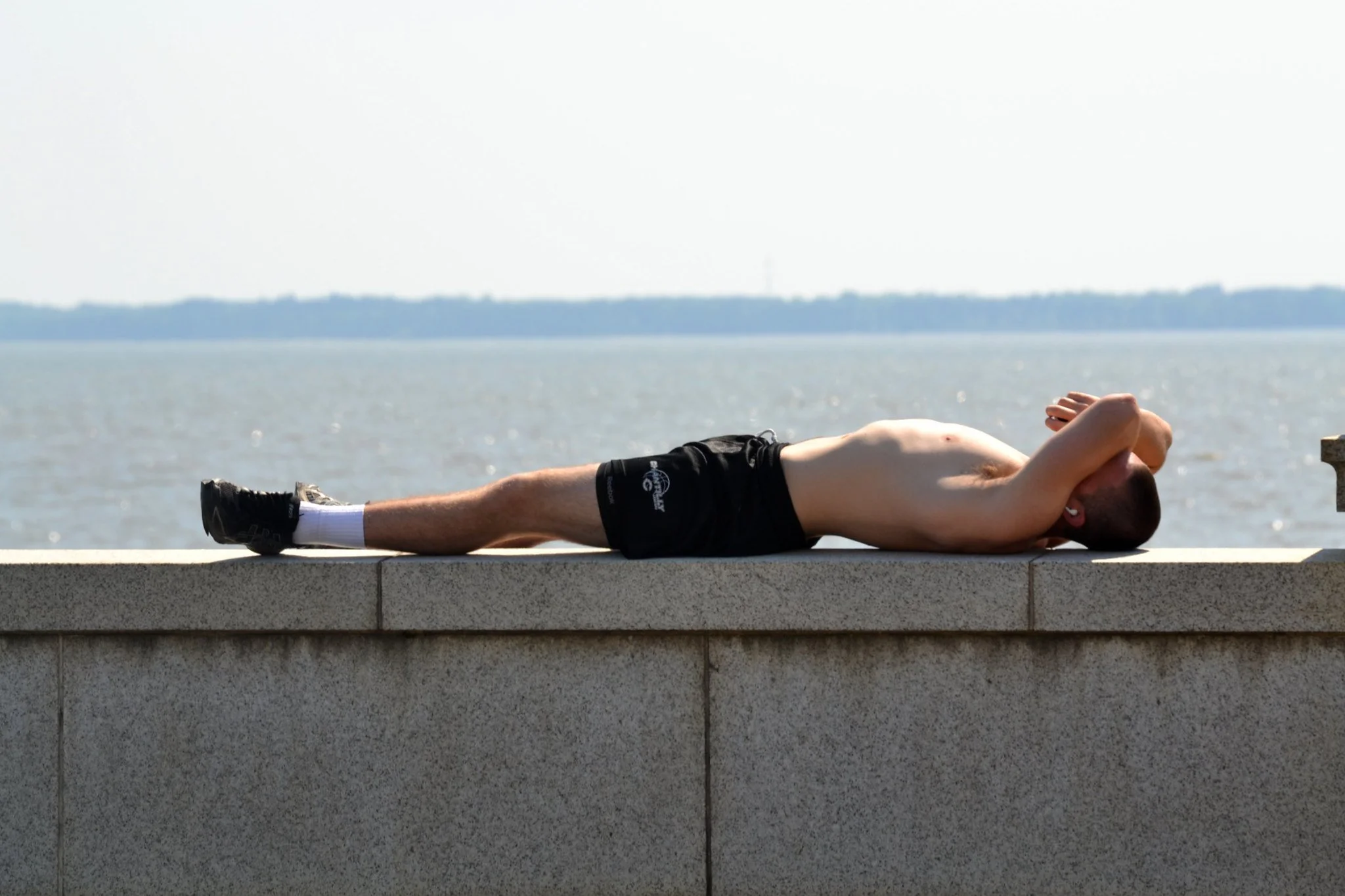Should A Man Tan?
Photo: Tony Alter / Flickr
Just because you can doesn’t mean you should.
We’ve all heard that one before.
Just because you can lie, doesn’t mean you should.
Just because Tom Cruise ran down the side of the world’s tallest building, doesn’t mean you should, too. By the way, does that psycho do all his own stunts? Man.
Often, if we’re questioning an act or choice that’ll otherwise feel good, there’s a good chance it’s the anticipated result that’ll face our scrutiny, and not the act itself.
Looking good feels good, and for a lot of people come summer, that includes rocking a tan.
Plus ladies love a man who can tan.
That doesn’t mean Irishmen strike out in the sun. It just means ladies love a man who can tan.
A tan looks great against a crisp, white tee. A tanned man tells the world he’s adaptive, literally, and that his hide can take it — and not burn — when those UVs do their worst.
But, just because a man can tan, does that mean a man should tan?
To get the four-one-one on maybe the most pressing health question this time of year, we consulted science itself, plus we called up our resident dermatologist and Director of the Toronto Dermatology Centre, Dr. Ben Barankin.
Let’s see what both said, Spartacus.
The Pre-Verdict Verdict
Yes, verdicts show up at the end of a case. But considering the subject matter at hand, best to be up front about this now: “Tanning causes wrinkles, brown spots and other blemishes,” confirms Dr. Barankin. “It can suppress your skin’s immune system, making you prone to cold sores, and eventually it’ll increase your risk of getting skin cancer years later.”
Remember — Dr. Barankin’s referring to tanning, not getting a healthy dose of sun.
Both are different.
“[Essentially], you’re slow-cooking your skin and damaging the DNA in your skin cells in the process,” says the good doc. “And as the damage builds up over time, it can cause cells to grow out of control. which ultimately leads to skin cancer!”
Got it?
With that out of the way, let’s keep going.
What’s What (Or A Quick Word On Vitamin D)
Our sun is a never ending well of vitamin D.
Plenty of research from the past decade has shown daily vitamin D supplementation staves off chronic diseases like diabetes, heart disease and tumours, and in some cases, it could save you an early visit from the icy grip itself — mortality.
How, right?
Like this 2017 report from the National Library for Biotech Info reminds us, “Vitamin D is one o the essential nutrients to sustain the human health,” not to mention the inexorable tie between autoimmune disease development and a vitamin D deficiency.
There’s even been debate among scientists over the vitamin’s actual value — some think it should graduate to hormone status. That’s how key it is to regulating our health.
And let’s not even get started on the “pandemic” of hypovitaminosis D (or vitamin D deficiency) that’s pervaded our world forever now.
Without regaling you with jargon, know that we absorb the awesomeness of vitamin D in two ways: 1) One’s old fashioned — by smashing food. 2) The “Superman” way — via ultraviolet rays that penetrate the skin, at which point it gets converted to vitamin D3, and smart money says you’ve heard of that one, too.
But get this: On average, a man will get 90% of his needed vitamin D from the sun, and the remaining 10% comes from food (think fish like tuna, sardines, salmon and pickerel).
The point is, the sun’s good for us in that it nourishes us with vitamin D, but getting vitamin D from tanning’s its own beast, and whether to not you should tan could hinge on your skin type.
It’s one thing to catch rays from a quick swim. But it’s another to lay out on a rooftop and fry.
What’s a good medium?
Check out the chart below (thank you, informedhealth.org) and you’ve got your answer.
But before you do, know your skin type based on the life-saving Fitzpatrick Scale — with one being the palest and most sensitive and six being the darkest level of brown-to-black skin — then measure it against the recommended, unprotected sun exposure time on the left.
Note that skin types V and VI run off the chart, such is their sun tolerance.
But if that’s you, it doesn’t mean too much sun won’t mess with your hide. If, say, you’re summering in Florida and your skin’s type V, give it a rest every hour and find some shade. A higher resistance to UV rays doesn’t mean you won’t burn.
And if you fair-skinned brothers are thinking it, yes, anything more than 10 minutes in direct sunlight and you’re asking for it.
Recommended Sun Exposure According to Good Old Genetics & Time
Say No To Tanning Beds
If you do it, stop. And if you want to, don’t.
You’ll find no shortage of tanning salons across every major city in this continent, but those things can — and will — ruin you.
Never mind a deep dive into the subject, just run a quick search on tanning beds and you’ll be hard pressed to find anything even remotely nice about it. You know what you will find, though? The dreaded “c” word.
“Sunburns and tanning salon usage are two of the major risk factors for the potentially deadly melanoma,” says Dr. Barankin. “Melanoma is the number one most diagnosed cancer among 25 to 29 year-olds in North America. And for 15 to 29-years-old, it’s the third most common form of cancer for men and the fourth most common one for women.”
There are actually three types of skin cancer: Basal cell cancer, squamous cell cancer (both are curable if caught early, think red, scaly spots, sores, and “wart-like” skin), and melanoma. “Basal cell cancer and squamous cell cancer are due to chronic sun exposure in most cases,” says Dr. Barankin. “Melanoma is more commonly from tanning salons and sunburns, but it can also be genetic and show up in places where the sun don’t shine!”
In other words, don’t get burnt, and never use a tanning bed.
Three Sunscreen Laws By Which Any Man Can Live Burn-Free
To anyone who’s new here, we published a sort of intro guide to staying safe in the sun two years ago. Check it out if you missed it.
Either way, there are words worth repeating ‘till time’s end, especially if searing your skin’s not on your agenda: If you’re going out there, cover up with a minimum of SFP 30, wear the right clothes, and if you’re south of the equator or out all day, go SPF 50 or higher.
“In North America we recommend a minimum of SPF30, but we also recommend avoiding mid-day sun,” says Dr. Barankin. “We also tell people to wear sun-protective clothing/rash guards, broad-brimmed hats, and sunglasses, too.”
“Most people aren’t putting on enough sunscreen and not reapplying every two to three hours when out and about, or after sweating or towelling as they should. If you’re facing a stronger sun (i.e. a Caribbean vacation) or if you’re planning to be outside for a while knowing you won’t reapply [sunscreen], I’d advise getting an SPF 50 or even a 60.”
The Verdict
Playing it safe might be boring, but it’ll save your life.
Here goes: If you’re at the top of the Fitzpatrick Scale (or halfway and up), then your margin of error might be broader, but we’d still avoid full, six-hour days in the sun sans protection.
And if you’re near the business end of this scale, get your vitamin D, by all means, but don’t tan (and watch the clock while you’re out there). Remember, the two are different.
Okay, that’s it.

